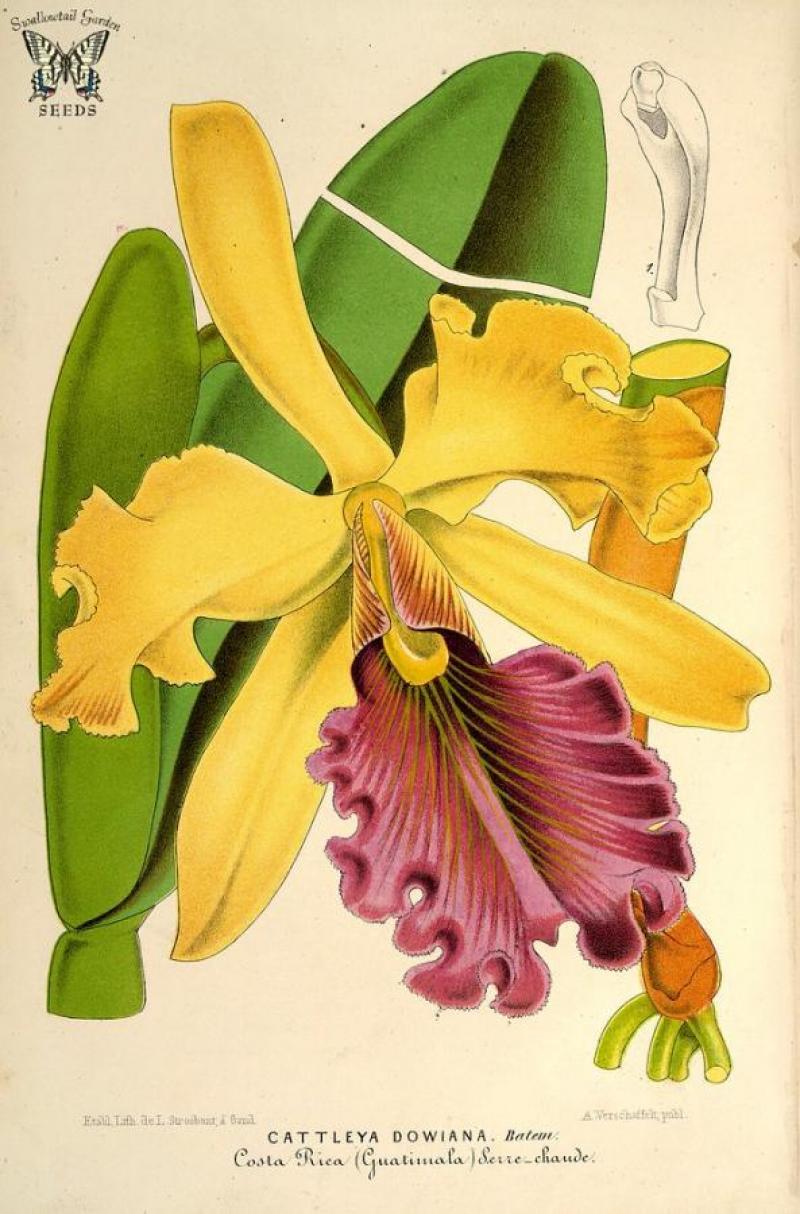Cattleya dowiana
Also known as: Guaria Reina or Cattleya aurea h.v. croteniana Cattleya aurea h.v. dureda Cattleya dowiana var. chrysotoxa Cattleya aurea h.v. chrysotoxa Cattleya aurea h.f. aurantiaca Cattleya dowiana h.v. statteriana Cattleya dowiana h.f. alba Cattleya aurea h.v. splendens Cattleya aurea h.v. musaica Cattleya aurea h.v. grandis Cattleya aurea h.v. magnifica Cattleya aurea h.f. flammea Cattleya labiata var. dowiana Cattleya dowiana h.v. moortebeekiensis Cattleya dowiana var. dowiana Cattleya dowiana var. chrysotaxa Cattleya chrysotaxa Cattleya labiata subvar. aurea Cattleya dowiana var. aurea Cattleya aurea Cattleya dowiana var. rosita Cattleya dowiana f. marmorata Cattleya dowiana ssp. aurea Cattleya dowiana f. rosita Cattleya dowiana var. aurea-alba Cattleya dowiana var. aurea-marmorata Cattleya dowiana f. carmoniana Cattleya chrysotoxa San Juanes Queen Of The Cattleyas Guaria De Turrialba Queen Orchid in the subfamily: Epidendroideae
Native to: Costa Rica Departamento del Huila - Colombia
General Information
Guaria Reina is a medium sized sympodial warm to hot growing epiphytic orchid belonging to the sub family Epidendroideae native to Costa Rica and Colombia.
Plant Description
Sympodial. Grows to 30cm. Each new growth has a single leathery leaf that grows to 15-30cm long. Pseudobulbs grow to 4-13cm
Flowers
Numerous short lasting, fragrant blossoms appear during Summer and Autumn
Fragrance
The orchid is fragrant. The fragrance can be described as pleasant and soapy
Blooming Season
- Autumn
- Summer
Substrate(s)
- Coarse
- Bark
Care Notes
These orchids like to be kept on the dry side, but may need to be watered daily during warm weather, and prefer a well draining mix or also do well mounted, provided they can be watered regularly.
These are quite a forgiving orchid, there are no special requirements to get this orchid to flower, just good care and consistent conditions. Larger plants may be more fussy and can react poorly to change; a poorly timed repotting, a pest infection or an unusually hot day can set them back for a couple of years. However, even plants that have been treated poorly can thrive, and if they are set back they often recover much stronger then they would otherwise be.
Fragrant:- IsFragrant
Climate
The orchids are well adapted for hot weather, accompanied by sporadic, unpredictable rainfall and a generally dry climate. They can tolerate a lot of neglect as they are quite used to it, however they can be prone to underwatering and may collapse in cold, wet weather.
For this reason it's best to dedicate a sheltered, protected area for them where the watering can be controlled, such as a corner of a greenhouse or in a sheltered balcony. They can also do well hung near the roof of a shadehouse or sheltered greenhouse where they receive the extra heat but not as much water as other plants.
Grows at low to high elevations. Rainfall ranges from 5mm to 305mm per day, heaviest in September and lightest in February. Humidity ranges from 68% to 85%, highest in October and lowest in March. Temperature ranges from 14C to 27C, highest in May (17C to 27C) and lowest in January (14C to 24C).Watering
Keep moisture levels up during hot weather as the plant is prone to dehydration
Fertiliser
Apply liquid based fertiliser per recommended directions. They can benefit from a high phosphate fertiliser leading up to flowering season, followed by a high nitrogen fertiliser when new growth appears, and a balanced fertiliser in other times. These orchids can also tolerate slow release fertiliser applied 1-2 pellets per cup (250ml) of media.
Apply fertiliser regularly at half strength year round. Use a high Nitrogen fertiliser during Spring and Summer. Use a high Phosphorous fertiliser during Summer. Reduce fertiliser when plant is dormant during Spring.Potting
These plants are quite forgiving and will do well repotted ever 2-3 years. The mix should be coarse, well draining, and allow space for air to move and for roots to grow.
Alternatively, these plants will also do well mounted to tree fern or cork slabs, or mounted to trees.
Best time for repotting or mounting the orchids is the end of winter when new growths start to appear. Avoid repotting during hot weather,
This plant does well mounted to Tree trunks, Fern slabs or Cork slabs.




















